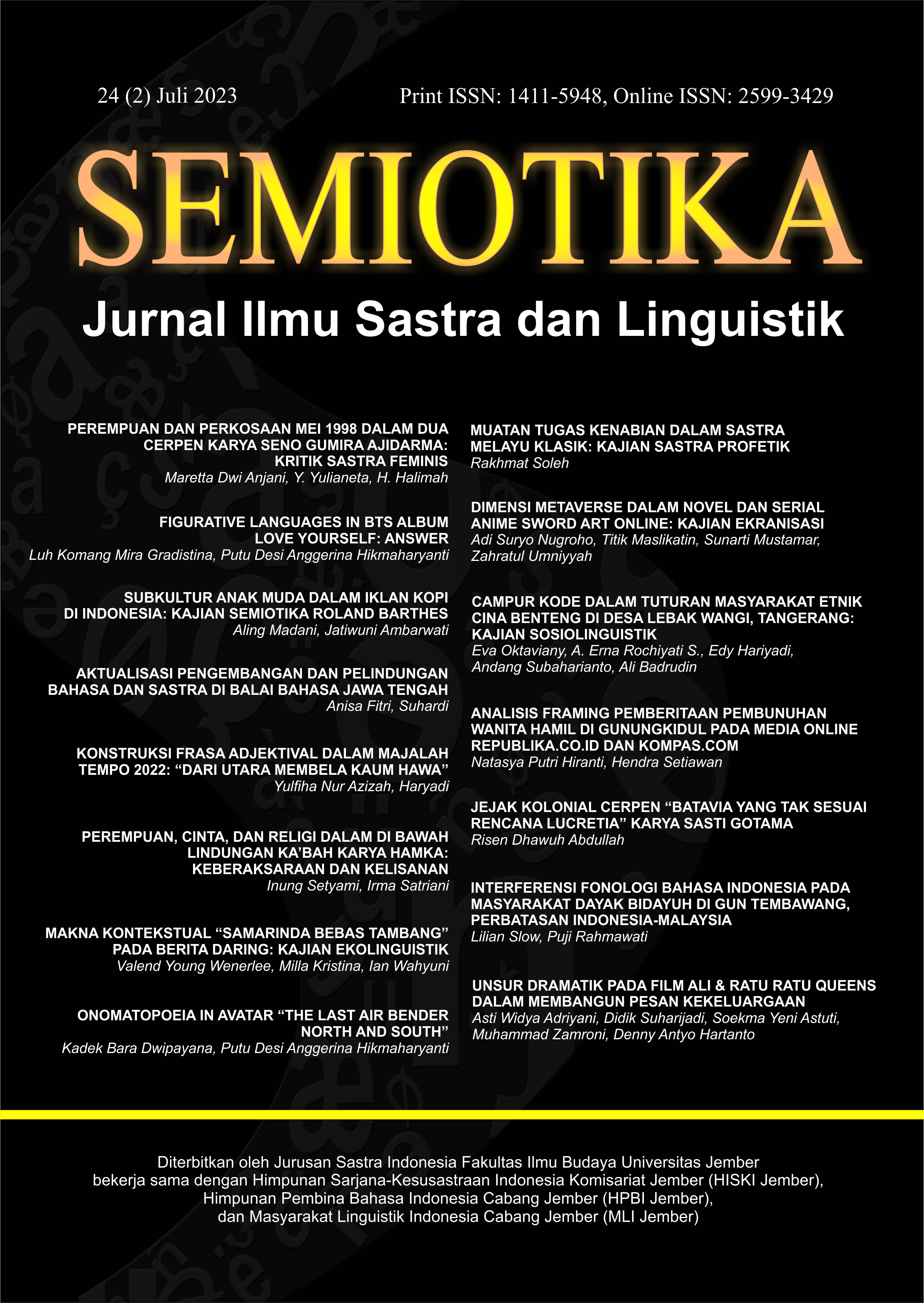SUBKULTUR ANAK MUDA DALAM IKLAN KOPI DI INDONESIA: KAJIAN SEMIOTIKA ROLAND BARTHES
DOI:
https://doi.org/10.19184/semiotika.v24i2.31091Keywords:
advertisement, semiotic, youth subculturesAbstract
The current trend and existence of coffee continues to develop into a part of the lifestyle of youth. Therefore, coffee products on the market are increasingly varied with various advertising strategies. Various advertising themes related to youth activities and identities are used to reach their target market. This study is a semiotic analysis that aims to describe the symbols and cultural styles of youth in coffee advertisements in Indonesia by using the concept of youth subculture. The focus of this research is the meaning of youth's visual signs represented through coffee advertisements in Indonesia. This study uses a qualitative method. The data collection technique was carried out by observing instant coffee advertisement impressions in Indonesia in the last five years, including the Torabika for the Gilus Mix variants (2021) and Cappuccino (2019), Top Coffee for the Gula Aren variant (2020), Neo Coffee version of Lucas (2019) and Tiramisu (2021), and Good Day (2018). Roland Barthes' semiotic analysis is used in this study to show the sign meanings in the coffee advertisement through the stages of denotative, connotative, and mythical meanings. The results of the study show that these coffee advertisements generate units of denotation, connotation, and myth which then represent the lifestyle of the youth subculture. It exists in various aspects and refers to urban youth culture with urban cultural influences as reflected in clothing/fashion styles, distinctive music, and entertainment activities.
Downloads
References
Day Coffee Versi “Rizky Febian & Tiara Andiniâ€â€. Jurnal Artikula, 5(1).
Barker, C. 2020. Cultural Studies: Teori dan Praktik. Purwanto, H. (Ed.). Penerjemah
Nurhadi. Yogyakarta: Kreasi Wacana.
Barthes, R. 1972. Mythologies. Diterjemahkan oleh Lavers, A. New York: Farrar, Straus &
Giroux.
Barthes, R. 1983. Elements of Semiology. Diterjemahkan oleh Lavers, A. & Smith, C. New
York: Hill and Wang.
Bernard, M. 2006. Fashion sebagai Komunikasi: Cara Mengkomunikasikan Identitas Sosial,
Seksual, Kelas, dan Gender. Diterjemahkan oleh Ibrahim, I.S. Yogyakarta &
Bandung: Jalasutra.
Chaney, D. 1996. Lifestyle: Sebuah Pengantar Komprehensif. Yogyakarta: Jalasutra.
Fasikh, M. & Murtadho, A.M. 2020. “A Semiotic Analysis Found on Kopi Kapal Api Special
Mix Ramadhan Edition Advertisementâ€. Journal of English Language and Literature,
5(2).
Fearherstone, M. 2001. Postmodernisme dan Budaya Konsumen. Yogyakarta: Pustaka
Pelajar.
Fowles, J. 1996. Advertising and Popular Culture. New York: SAGE Publications.
Fratini, A., & Wenerda, I. 2022. “Representasi Anak Muda pada Iklan Good Day “Cari Terus
Rasamuâ€â€. EKSPRESI, 11(1).
Gandhi, A.M. 2020. “Semiotics Analysis of Ruangguru Advertising in Television Mediaâ€.
MetaCommunication: Journal of Communication Studies, 5(2).
Hendariningrum, R. & Susilo, M. E. 2008. “Fashion dan Gaya Hidup: Identitas dan
Komunikasiâ€. Jurnal Ilmu Komunikasi, 6(2).
Hoed, B. H. 2011. Semiotika dan Dinamika Sosial Budaya. Jakarta: Komunitas Bambu.
Ibrahim, I.S. 1996. Lifestyle: Sebuah Pengantar Komprehensif David Chaney. Yogyakarta:
Jalasutra
IDN Times. 2017. “Ini Dia 5 Alasan EDM Jadi Musik Favorit Para Milenialâ€.
https://www.google.com/amp/s/www.idntimes.com/hype/viral/amp/ivan-tirta/ini-dia5-alasan-edm-jadi-musik-favorit-para-millenials-csc-1, diakses 25 Januari 2022.
Kristofel, J. 2010. “Bagi Anak Muda, Musik Itu Adalah Alat Pemersatuâ€.
https://finance.detik.com/berita-ekonomi-bisnis/d-1429512/bagi-anak-muda-musikitu-adalah-alat-pemersatu, diakses 25 Januari 2022.
Kumparan HITS. 2017. “Tren Musik 2017: Apakah EDM Masih Mendominasi?â€
https://www.google.com/amp/s/m.kumparan.com/amp/kumparanhits/tren-musik2017-apakah-edm-masih-mendominasi, diakses 25 Januari 2022.
Kumparan. 2017 “Memahami Selera Musik Generasi Milenialâ€.
(https://www.google.com/amp/s/m.kumparan.com/amp/kumparanstyle/memahamiselera-musik-generasi-milenial, diakses 25 Januari 2022.
Kurniawan. 2001. Semiologi Roland Barthes. Magelang: Yayasan Indonesiatera.
Mayr, S.W. 2013. “Reading Culture in TV Commercials A Semiotic Analysis of a TV
Commercial for The Purpose of Teaching Cultural to Foreign Language Studentsâ€.
International Journal of Arts and Commerce, 2(1).
Mitchell, T. 2003. Australian Hip Hop as a Subculture. Sydney: Local Noise.
Moleong, L. 2006. Metodologi Penelitian Kualitatif. Bandung: Remaja Rosdakarya.
Nyanoti, J.N. 2015. Media and the Creation of Self-Identity: An Assessment of How the
Kenyan Youth Construct Their Self-Identities Through Consumption of Television
Advertisements. Tesis. Nairobi: University of Nairobi.
Pangestu, I.P. 2018. “Representasi Anak Muda dalam Iklan Televisi: Analisis Semiotik Iklan
Extra Joss Blend Versi Aliando dan Mizone Versi Bantu Semangat Oke Lagiâ€.
Naskah Publikasi. Yogyakarta: Fakultas Psikologi dan Ilmu Sosial Budaya Universitas
Islam Indonesia.
Parwata. 2019. “Saat Ini Vespa Matik Jadi Idaman Pelajar SMA, Tahu Nggak Sebelumnya
Motor Apa?â€
https://www.google.com/amp/s/otomania.gridoto.com/amp/read/241898659/saat-inivespa-matik-jadi-idaman-pelajar-sma-tahu-nggak-sebelumnya-motor-apa, diakses 25
Januari 2022.
Piliang, Y.A. 1998. Sebuah Dunia yang Dilipat, Realitas Kebudayaan Menjelang Milenium
Ketiga dan Matinya Postmodernisme. Yogyakarta: Mizan.
Prasetiyo, A. 2022. “Gambaran Maskulinitas dalam Iklan Kopi Caffino di Instagramâ€. Jurnal
Communio: Jurnal Jurusan Ilmu Komunikasi, 11(1).
Prasojowati, M.W., dkk. 2019. “A Semiotic Analysis Found on the Cigarette Productsâ€.
Jurnal Ilmu Budaya, 3(1).
Sobur, A. 2016. Semiotika Komunikasi. Bandung: Remaja Rosdakarya.
Triandjojo, I. 2008. “Semiotika Iklan Mobilâ€. Tesis. Semarang: Program Pascasarjana
Universitas Diponegoro.
Turow, J. 2011. Media Today: An Introduction to Mass Communication (4th ed.). New York:
Routledge.
Wardani, A. W. A., Pratama, S. A., & Sazali, H. 2023. “Analisis Representase Maskulinitas
Dalam Iklan Kopi Luwak Sin Tae Yongâ€. Jurnal Riset Rumpun Seni, Desain dan
Media (JURRSENDEM), 2(1).
Williamson, J. 1978. Decoding Advertisements: Ideology and Meaning in Advertising.
London: Marion Boyars.
Downloads
Published
Issue
Section
License
SEMIOTIKA has CC-BY-SA or an equivalent license as the optimal license for the publication, distribution, use, and reuse of scholarly work. Authors who publish with this journal retain copyright and grant the journal right of first publication with the work simultaneously licensed under a Creative Commons Attribution-ShareAlike 4.0 International License that allows others to share the work with an acknowledgment of the work's authorship and initial publication in this journal.
Attribution-ShareAlike
CC BY-SA


